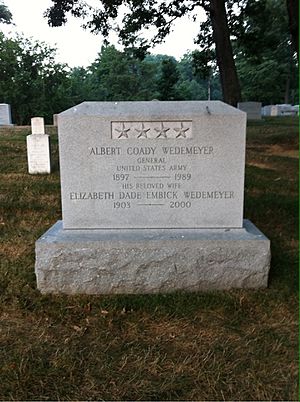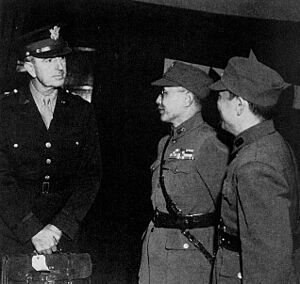Albert Coady Wedemeyer facts for kids
Quick facts for kids
Albert Coady Wedemeyer
|
|
|---|---|
 |
|
| Born | July 9, 1896 Omaha, Nebraska, US |
| Died | December 17, 1989 (aged 93) Fort Belvoir, Virginia, US |
| Buried | |
| Allegiance | United States |
| Service/ |
United States Army |
| Years of service | 1919–1951 |
| Rank | General |
| Service number | 0-12484 |
| Commands held | Sixth United States Army |
| Battles/wars | World War II
|
| Awards | Army Distinguished Service Medal (3) Legion of Merit Presidential Medal of Freedom Order of Blue Sky and White Sun (China) |
| Other work | Author |
General Albert Coady Wedemeyer (born July 9, 1896 – died December 17, 1989) was an important commander in the United States Army. He served in Asia during World War II from 1943 until the war ended. Before that, he helped plan the Normandy invasion.
In 1942, he worked closely with General George C. Marshall. They traveled to London to talk with British leaders. Their goal was to get British support for a major invasion across the English Channel. Wedemeyer was also strongly against communism. From 1944 to 1945, he was Chiang Kai-shek's Chief of Staff in China. He led all American forces there. Wedemeyer supported Chiang's fight against Mao Zedong. In 1947, President Truman sent him back to China. He was asked to write a report on what the United States should do. During the Cold War, Wedemeyer was a big supporter of the Berlin Airlift.
Contents
Early Life and Military Training
Albert Coady Wedemeyer was born on July 9, 1896. His hometown was Omaha, Nebraska. He went to Creighton Preparatory School.
In 1919, he graduated from the United States Military Academy at West Point, New York. He spent many years as a lieutenant. He was finally promoted to captain in 1935.
Between 1936 and 1938, Captain Wedemeyer studied at the Prussian Military Academy in Berlin. He learned about armored warfare from Heinz Guderian. He also met important Nazi Party leaders. After his studies, he watched the German Army's large training exercises in 1938.
When he returned to Washington, Wedemeyer studied Nazi Germany's plans. He became the top expert in the U.S. military on German tactics. His father-in-law, Lieutenant General Stanley Dunbar Embick, also helped his career.
World War II Service
When World War II began, Wedemeyer was a lieutenant colonel. He worked in the War Plans Division. In 1941, he wrote the "Victory Program". This plan said that defeating Germany in Europe should be the main goal for the United States. This plan was later used and grew bigger as the war continued. Wedemeyer also helped plan the Normandy Invasion.
Leading Forces in Asia
In 1943, Wedemeyer was sent to Southeast Asia. He became Chief of Staff to Lord Louis Mountbatten. Mountbatten was the Supreme Allied Commander there.
On October 27, 1944, Wedemeyer received a message. General George C. Marshall told him to go to China. He was to take command of all United States forces there. He replaced General Joseph Stilwell. Wedemeyer also became Chief of Staff to Generalissimo Chiang Kai-shek.
Wedemeyer was worried about this new job. Serving in China was known to be very difficult for American officials. When he arrived, General Stilwell had already left. Stilwell did not leave any notes or plans for Wedemeyer. This made it hard for Wedemeyer to understand the situation.
While in China, Wedemeyer tried to get the Chinese Nationalist government to fight harder against the Imperial Japanese Armed Forces. He helped improve the "the Hump" airlift. This operation flew supplies over mountains. He also continued programs to train and equip the National Revolutionary Army. His efforts were not completely successful. This was partly due to problems left by his predecessor. There were also ongoing disagreements about the role of the Chinese Communist Party's army.
Wedemeyer's advice helped the Nationalist Army. They defeated Japanese forces in the Battle of West Hunan. They also took back the cities of Guilin and Liuzhou. Wedemeyer also managed supplies for the United States Army Air Forces in China. These included the Twentieth Air Force and the Fourteenth Air Force. The Fourteenth Air Force was led by General Claire Lee Chennault.
In December 1945, Wedemeyer, General Douglas MacArthur, and Admiral Raymond A. Spruance made a recommendation. They suggested moving six more Chinese Nationalist armies into North China and Manchuria. They also suggested that U.S. help to China should be used to encourage peace talks. These talks would try to unite the different Chinese groups.
After Japan surrendered, Wedemeyer became concerned. Some Japanese troops were surrendering to Communist Chinese forces. He wanted seven American divisions sent to China. However, General Marshall said that Japan and Korea were more important. Wedemeyer stayed in China until 1946.
After the War
After returning from China, Wedemeyer became the Army Chief of Plans and Operations. In July 1947, President Harry S. Truman sent Wedemeyer to China and Korea. His job was to study the "political, economic, psychological, and military situations." This led to the Wedemeyer Report. In this report, Wedemeyer said the United States needed to train and help the Nationalist armies a lot.
Wedemeyer's 1947 report showed a difficult situation in the Chinese Civil War. Chiang's armies had better equipment than the Communists. But they lacked ammunition, fuel, and spare parts. These supplies had been promised but were not delivered. Many Nationalist trucks could not be used. Ammunition shortages caused them to lose battles. They had to search abandoned American supply dumps. Also, much extra weaponry in the Pacific was being destroyed. Chiang's government was charged very high prices for what was left. For example, bazookas were sold cheaply to Greece. But China had to pay much more. Wedemeyer suggested fixing these problems right away. He wanted leftover equipment sent to China instead of being destroyed.
President Harry S. Truman did not trust the Nationalist government. He rejected Wedemeyer's suggestions. He also stopped sending weapons to the Nationalist government. This made the debate about America's role in the Chinese Civil War even stronger. Secretary of State George C. Marshall had hoped Wedemeyer could convince Chiang Kai-shek to make reforms. Marshall supported Truman's decision and kept Wedemeyer's report from being published. This made many people upset. The report was later published in the 1949 China White Paper.
After his report, Wedemeyer took command of the Sixth United States Army in San Francisco, California. He felt he was no longer involved in major military decisions.
After the Communists won in China in 1949, Wedemeyer spoke to Congress. He said that the Nationalist forces lost morale. But he also said that the Truman administration's decision to stop training and helping them was a main reason. The U.S. stopping weapon sales also hurt them. Wedemeyer believed that if American military advisers had worked with Nationalist armies, they would have fought better.
Other military leaders, like Vice Admiral Oscar C. Badger, General Claire Chennault, and Brigadier General Francis Brink, agreed. They said the arms embargo was a big reason for the loss of China.
In 1948, Wedemeyer supported General Lucius D. Clay's plan. This plan created an airbridge during the Berlin Crisis.
After the Communist victory in 1949, Wedemeyer became a strong critic of those he felt were responsible. He gave many speeches across the country. He retired as a lieutenant general in 1951. He was promoted to full general by Congress on July 19, 1954.
On May 23, 1985, President Ronald Reagan gave him the Presidential Medal of Freedom.
Death and Legacy

General Wedemeyer died on December 17, 1989. He passed away at Fort Belvoir, Virginia. He and his wife, Elizabeth Dade Embick, are buried in Arlington National Cemetery.
His home, Friends Advice, in Boyds, Maryland, was where he lived for many years. It is now a historic place.
Dates of Rank
| No insignia | Cadet, United States Military Academy: June 14, 1917 |
| Second Lieutenant, Regular Army: November 1, 1918 | |
| First Lieutenant, Regular Army: February 27, 1920 | |
| Second Lieutenant, Regular Army: December 15, 1922 | |
| First Lieutenant, Regular Army: June 24, 1924 | |
| Captain, Regular Army: August 1, 1935 | |
| Major, Regular Army: July 1, 1940 | |
| Lieutenant Colonel, Army of the United States: September 15, 1941 | |
| Colonel, Army of the United States: February 1, 1942 | |
| Brigadier General, Army of the United States: July 7, 1942 | |
| Lieutenant Colonel, Regular Army: December 11, 1942 | |
| Major General, Army of the United States: September 20, 1943 | |
| Lieutenant General, Army of the United States: January 1, 1945 | |
| Brigadier General, Regular Army: April 6, 1946 | |
| Major General, Regular Army: January 24, 1948 | |
| Lieutenant General, Retired list: June 23, 1951 | |
| General, Regular Army, Retired List: July 19, 1954 |
Images for kids
See also
 In Spanish: Albert Coady Wedemeyer para niños
In Spanish: Albert Coady Wedemeyer para niños



